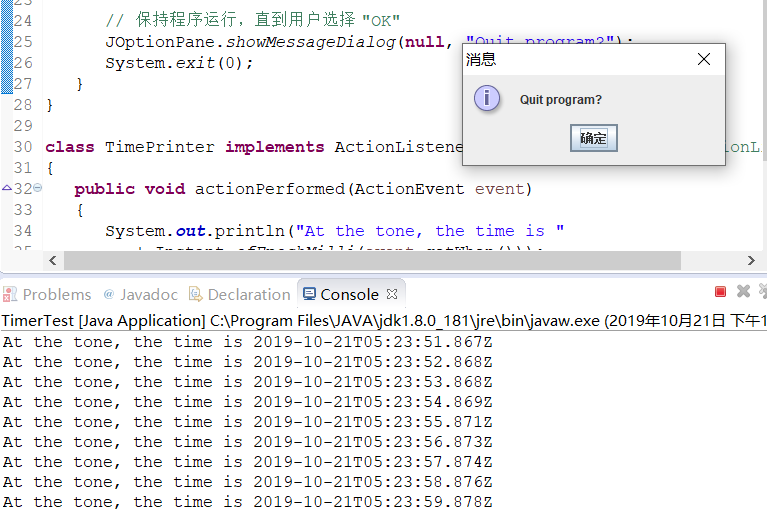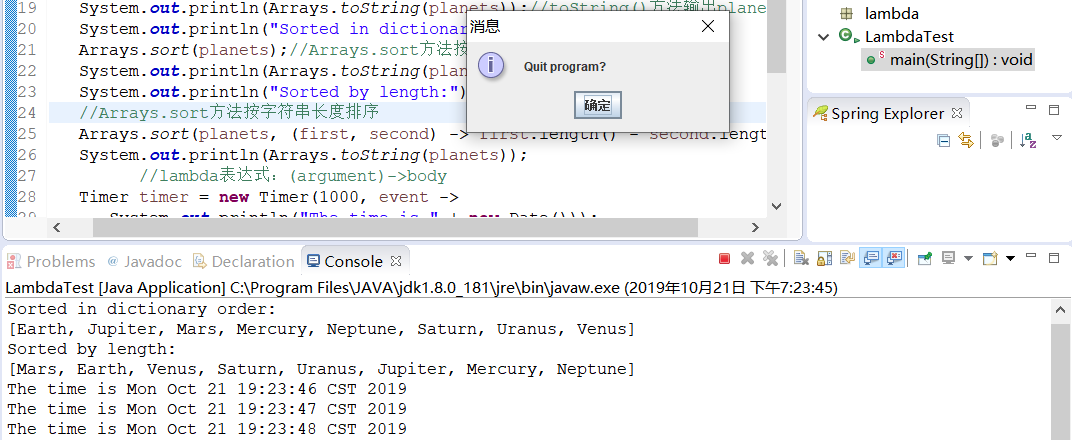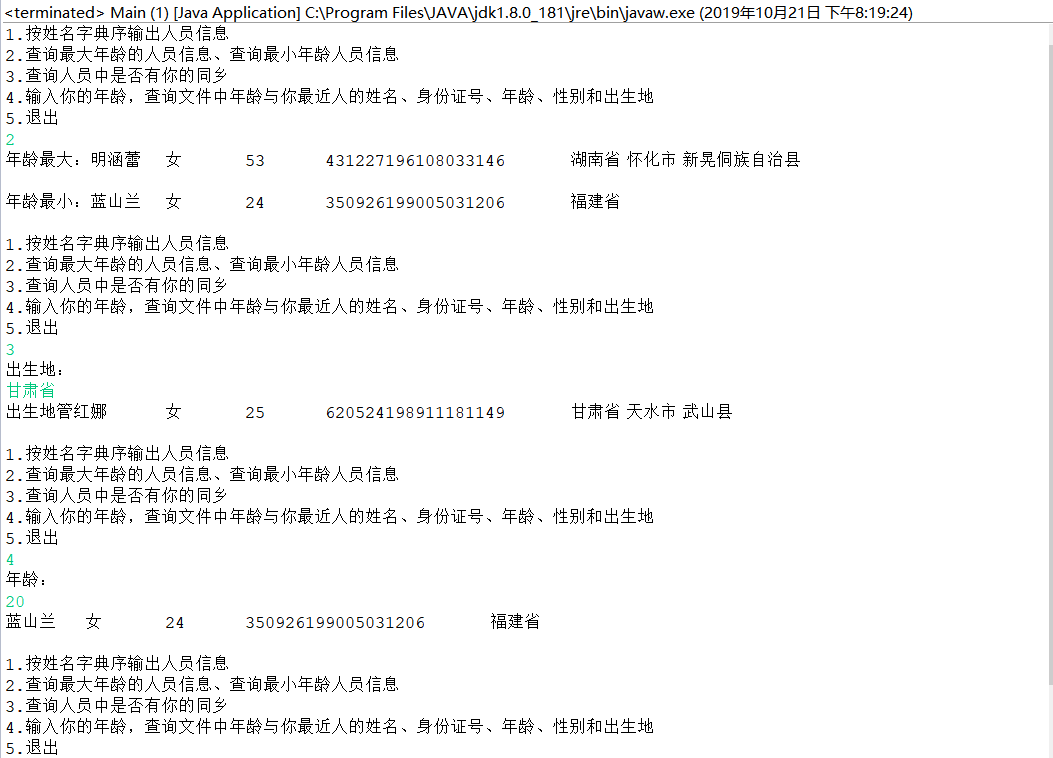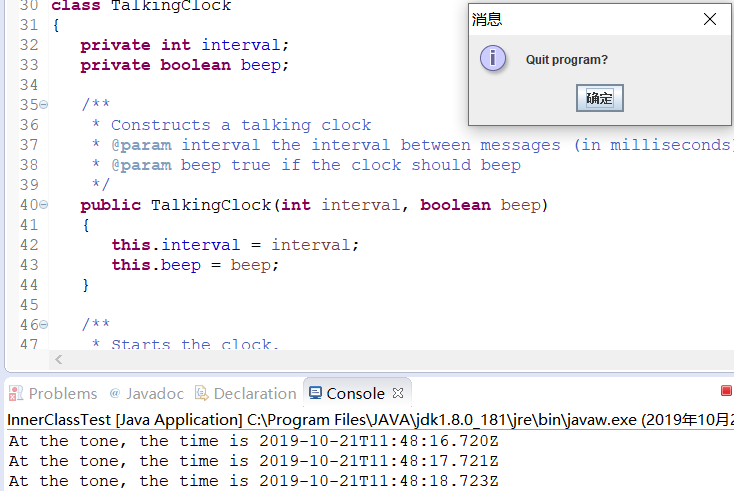20187101035 张玉晶《面向对象程序设计(java)》第八周学习总结
201871010135 张玉晶 《面向对象程序设计(java)》第八周学习总结》
|
项目 |
内容 |
|
这个作业属于哪个课程 |
<任课教师博客主页链接> https://www.cnblogs.com/nwnu-daizh/ |
|
这个作业的要求在哪里 |
<作业链接地址>https://www.cnblogs.com/nwnu-daizh/p/11703678.html |
|
作业学习目标 |
|
第一部分:总结第六章理论知识
一: 接口:
a. Java为了克股单继承的缺点。Java使用了接口,一个类可以实现一个或多个接口.
b. 在Java中。 接口不是类而是对类的一组需求描述。由常量和一组抽象方法组成.
c. 接口中不包括变量和有具体实现的方法。
d. 接口不能构造接口对象,但可以声明接口变量
e. 自定义接口的声明: public interface 接口名
f. 类实现某个接口: class 类 inplements 接口名
g. 接口可以扩展 public interface 接口1 extends 接口2
h. int compareTo(T other)
用这个对象与other进行比较,如果这个对象小于other则返回负值,如果相等则返回0,否则返回正值。
static void sort(Object[ ] a)
对数组a中的元素进行排序。要求数组中的元素必须属于实现了Comparable接口的类,并且元素之间必须是可比较的。
static int compare(int x,int y)7
如果x<y返回一个一个负整数,如果x和y相等,则返回0,否则返回一个负整数。
static int compare(double x,double y)1.4
如果x<y返回一个负数,如果x和y相等则返回一个0,否则返回一个负数。
i. 接口与抽象类的区别:
(1)接口不能实现任何方法,而抽象类可以;
(2)类可以实现很多接口,但只有一个父类;
(3)接口不是一个类分级结构中的一部分,无任何联系的类可以实现相同的接口。
二:接口示例:
1. 接口与回调:回调:一种程序设计模式,可以指出某个特定事件发生时应该采取的动作。java.swing包中Timer类,可以使用它在到达给定的时间间隔时触发一个事件。
2. 对象克隆: 当拷贝一个对象变量时,原始变量与拷贝变量引用同一个对象,这样,改变一个变量所引用的对象会对另一个变量产生影响;
如果要创建一个对象新的copy,它的最初状态与original一样,但以后可以各自改变状态,就需要使用0bject类的clone方法。
三:Lambda表达式:
(String first,String second) -> first.length() - second.length() 参数 箭头 表达式
1 .参数类型可推导时.不得要指定类型.如(a)> System.out.println(a)
2. 只有一个参数且类型可推导时。不强制写()
3. 参数指定类型时。必须有括号。
四:内部类:
1. 内部类可以直接访问外部类的成员保括private成员,但是内部类的成员却不能被外部类直接访问。
2. 在内部类对象保存了一个对外部类对象的引用,当内部类的成员方法中访问某一变量时, 如果在该方法和内部类中都未定义过这个变里,内部类中对变里的引用会被传递给外部类对象的引用。
3. 内部类并非只能在类内定义,也可以在程序块内定义局部内部类。例如,在方法中,甚至在for循环体内部。
4. 局部内部类不能用publi c或pr ivate访问修饰符进行声明,它的作用域被限定在声明这个局部类的块中。
匿名内部类
1. 若只创建类的一个对象,则不必为该类命名,这种类称为匿名内部类。
2. 由于匿名类没有类名,所以匿名类不能有构造器,取而代之的是将构造器参数传递给超类的构造器。若匿名内部类实现接口时,则匿名内部类不能有任何构造参数。
3. 如果构造参数的闭圆括号跟一个开花括号,表明正在定义的就是匿名内部类
静态内部类: 静态内部类不持有外部类的引用,只能访问外部类的静态成员变量和方法,而不能访问外部类的非静态成员属性和非静态方法,如果要调用和访问,必须实例化外部类对象。
当静态内部类拥有和外部类同名的成员变量或者方法时,会发生隐藏现象,即默认情况下访问的
是静态内部类的成员。如果要访问外部类的非静态同名成员,不能再使用外部类.this.成员的形式,而是要实例化外部类对象。如果要访问外部类的静态同名成员,可以通过外部类.成员的方式来访问。
与常规内部类不同,静态内部类可以有静态变量和静态方法。可以通过外部类.内部类.静态成员方式来访问。
第二部分
1、实验目的与要求
(1) 掌握接口定义方法;
(2) 掌握实现接口类的定义要求;
(3) 掌握实现了接口类的使用要求;
(4) 掌握程序回调设计模式;
(5) 掌握Comparator接口用法;
(6) 掌握对象浅层拷贝与深层拷贝方法;
(7) 掌握Lambda表达式语法;
(8) 了解内部类的用途及语法要求。
2、实验内容和步骤
实验1: 导入第6章示例程序,测试程序并进行代码注释。
测试程序1:
EmployeeSortTest.java
package interfaces; import java.util.*; /**
* This program demonstrates the use of the Comparable interface.
* @version 1.30 2004-02-27
* @author Cay Horstmann
*/
public class EmployeeSortTest
{
public static void main(String[] args)
{
Employee[] staff = new Employee[]; staff[] = new Employee("Harry Hacker", );
staff[] = new Employee("Carl Cracker", );
staff[] = new Employee("Tony Tester", ); Arrays.sort(staff);//使用Arrays类的sort方法,对Employee 对象数组进行排序 // 打印出关于 Employee 类的所有信息
for (Employee e : staff)
System.out.println("name=" + e.getName() + ",salary=" + e.getSalary());
}
}
运行结果如下:

a. Employee.java:
package interfaces; public class Employee implements Comparable<Employee>//Employee类实现泛型Comparable接口
{
private String name;
private double salary; public Employee(String name, double salary)
{
this.name = name;
this.salary = salary;
} public String getName()
{
return name;
} public double getSalary()
{
return salary;
} public void raiseSalary(double byPercent)
{
double raise = salary * byPercent / ;
salary += raise;
} /**
* Compares employees by salary
* @param other another Employee object
* @return a negative value if this employee has a lower salary than
* otherObject, 0 if the salaries are the same, a positive value otherwise
*/
//实现compareTo方法
public int compareTo(Employee other)
{
return Double.compare(salary, other.salary);
}
}
运行结果如下:

b.:
package interfaces; public class Employee implements Comparable<Employee>//Employee类实现泛型Comparable接口
{
private String name;
private double salary; public Employee(String name, double salary)
{
this.name = name;
this.salary = salary;
} public String getName()
{
return name;
} public double getSalary()
{
return salary;
} public void raiseSalary(double byPercent)
{
double raise = salary * byPercent / ;
salary += raise;
} /**
* Compares employees by salary
* @param other another Employee object
* @return a negative value if this employee has a lower salary than
* otherObject, 0 if the salaries are the same, a positive value otherwise
*/
//实现compareTo方法
public int compareTo(Employee other)
{
return name.compareTo(other.name);//按姓名排序
}
}
测试程序2:
编辑、编译、调试以下程序,结合程序运行结果理解程序;
|
interface A { double g=9.8; void show( ); } class C implements A { public void show( ) {System.out.println("g="+g);} }
class InterfaceTest { public static void main(String[ ] args) { A a=new C( ); a.show( ); System.out.println("g="+C.g); } } |
Interface Test.java:
package interfaces;
interface A //自定义一个接口A
{
double g=9.8;
void show( );
}
class C implements A//类C 实现接口A
{
public void show( )
{System.out.println("g="+g);}
} class InterfaceTest
{
public static void main(String[ ] args)
{
A a=new C( );
a.show( );
System.out.println("g="+C.g);
}
}
运行结果如下:

测试程序3:
在elipse IDE中调试运行教材223页6-3,结合程序运行结果理解程序;
TimerTest.java:
package timer; /**
@version 1.02 2017-12-14
@author Cay Horstmann
*/ import java.awt.*;
import java.awt.event.*;
import java.time.*;
import javax.swing.*; public class TimerTest
{
public static void main(String[] args)
{
ActionListener listener = new TimePrinter(); // 构造一个listener的计时器
// once every second
Timer t = new Timer(, listener);
t.start(); // 保持程序运行,直到用户选择 "OK"
JOptionPane.showMessageDialog(null, "Quit program?");
System.exit();
}
} class TimePrinter implements ActionListener//类TimePrinter实现接口ActionListener
{
public void actionPerformed(ActionEvent event)
{
System.out.println("At the tone, the time is "
+ Instant.ofEpochMilli(event.getWhen()));
Toolkit.getDefaultToolkit().beep();
}
}
运行结果如下:

测试程序4:
调试运行教材229页-231页程序6-4、6-5,结合程序运行结果理解程序;
CloneTest.java:
package clone; /**
* This program demonstrates cloning.
* @version 1.11 2018-03-16
* @author Cay Horstmann
*/
public class CloneTest
{
public static void main(String[] args) throws CloneNotSupportedException //如果在一个对象上调用clone,如果对象的类没有实现Cloneable的接口。clone方法就会抛出CloneNotSupportedException
{
Employee original = new Employee("John Q. Public", );
original.setHireDay(, , );
//clone方法创建新对象copy,初始状态与Original相同,之后有不同的状态
Employee copy = original.clone();
copy.raiseSalary();
copy.setHireDay(, , );
System.out.println("original=" + original);
System.out.println("copy=" + copy);
}
}
运行结果如下:

Employee.java:
package clone; import java.util.Date;
import java.util.GregorianCalendar; public class Employee implements Cloneable// Employee类 实现Cloneable接口
{
private String name;
private double salary;
private Date hireDay; public Employee(String name, double salary)
{
this.name = name;
this.salary = salary;
hireDay = new Date();
} public Employee clone() throws CloneNotSupportedException //如果在一个对象上调用clone,如果对象的类没有实现Cloneable的接口。clone方法就会抛出CloneNotSupportedException
{
// call Object.clone()
Employee cloned = (Employee) super.clone(); // 克隆可变字段
cloned.hireDay = (Date) hireDay.clone(); return cloned;
} /**
* Set the hire day to a given date.
* @param year the year of the hire day
* @param month the month of the hire day
* @param day the day of the hire day
*/
public void setHireDay(int year, int month, int day)
{
Date newHireDay = new GregorianCalendar(year, month - , day).getTime(); // example of instance field mutation
hireDay.setTime(newHireDay.getTime());
} public void raiseSalary(double byPercent)
{
double raise = salary * byPercent / ;
salary += raise;
} public String toString()
{
return "Employee[name=" + name + ",salary=" + salary + ",hireDay=" + hireDay + "]";
}
}
运行结果如下:

实验2: 导入第6章示例程序6-6,学习Lambda表达式用法。
LambdaTest.java:
package lambda; import java.util.*; import javax.swing.*;
import javax.swing.Timer; /**
* This program demonstrates the use of lambda expressions.
* @version 1.0 2015-05-12
* @author Cay Horstmann
*/
public class LambdaTest
{
public static void main(String[] args)
{
String[] planets = new String[] { "Mercury", "Venus", "Earth", "Mars",
"Jupiter", "Saturn", "Uranus", "Neptune" };
System.out.println(Arrays.toString(planets));//toString()方法输出planets
System.out.println("Sorted in dictionary order:");
Arrays.sort(planets);//Arrays.sort方法按字符顺序排序
System.out.println(Arrays.toString(planets));
System.out.println("Sorted by length:");
//Arrays.sort方法按字符串长度排序
Arrays.sort(planets, (first, second) -> first.length() - second.length());
System.out.println(Arrays.toString(planets));
//lambda表达式:(argument)->body
Timer timer = new Timer(, event ->
System.out.println("The time is " + new Date()));
timer.start(); // 程序保持运行,直到用户选择 "OK"
JOptionPane.showMessageDialog(null, "Quit program?");
System.exit();
}
}
运行结果如下:

实验3: 编程练习
l 编制一个程序,将身份证号.txt 中的信息读入到内存中;
l 按姓名字典序输出人员信息;
l 查询最大年龄的人员信息;
l 查询最小年龄人员信息;
l 输入你的年龄,查询身份证号.txt中年龄与你最近人的姓名、身份证号、年龄、性别和出生地;
l 查询人员中是否有你的同乡。
程序代码如下:
package ID; import java.io.BufferedReader;
import java.io.File;
import java.io.FileInputStream;
import java.io.FileNotFoundException;
import java.io.IOException;
import java.io.InputStreamReader;
import java.util.ArrayList;
import java.util.Scanner;
import java.util.Collections; public class Main {
private static ArrayList<Citizen> citizenlist; public static void main(String[] args) {
citizenlist = new ArrayList<>();
Scanner scanner = new Scanner(System.in);
File file = new File("D://身份证号.txt");
try {
FileInputStream fis = new FileInputStream(file);
BufferedReader in = new BufferedReader(new InputStreamReader(fis));
String temp = null;
while ((temp = in.readLine()) != null) { Scanner linescanner = new Scanner(temp); linescanner.useDelimiter(" ");
String name = linescanner.next();
String id = linescanner.next();
String sex = linescanner.next();
String age = linescanner.next();
String birthplace = linescanner.nextLine();
Citizen citizen = new Citizen();
citizen.setName(name);
citizen.setId(id);
citizen.setSex(sex);
// 将字符串转换成10进制数
int ag = Integer.parseInt(age);
citizen.setage(ag);
citizen.setBirthplace(birthplace);
citizenlist.add(citizen); }
} catch (FileNotFoundException e) {
System.out.println("信息文件找不到");
e.printStackTrace();
} catch (IOException e) {
System.out.println("信息文件读取错误");
e.printStackTrace();
}
boolean isTrue = true;
while (isTrue) { System.out.println("1.按姓名字典序输出人员信息");
System.out.println("2.查询最大年龄的人员信息、查询最小年龄人员信息");
System.out.println("3.查询人员中是否有你的同乡");
System.out.println("4.输入你的年龄,查询文件中年龄与你最近人的姓名、身份证号、年龄、性别和出生地");
System.out.println("5.退出");
int nextInt = scanner.nextInt();
switch (nextInt) {
case :
Collections.sort(citizenlist);
System.out.println(citizenlist.toString());
break;
case :
int max = , min = ;
int m, k1 = , k2 = ;
for (int i = ; i < citizenlist.size(); i++) {
m = citizenlist.get(i).getage();
if (m > max) {
max = m;
k1 = i;
}
if (m < min) {
min = m;
k2 = i;
}
}
System.out.println("年龄最大:" + citizenlist.get(k1));
System.out.println("年龄最小:" + citizenlist.get(k2));
break;
case :
System.out.println("出生地:");
String find = scanner.next();
String place = find.substring(, );
for (int i = ; i < citizenlist.size(); i++) {
if (citizenlist.get(i).getBirthplace().substring(, ).equals(place))
System.out.println("出生地" + citizenlist.get(i));
}
break;
case :
System.out.println("年龄:");
int yourage = scanner.nextInt();
int near = peer(yourage);
int j = yourage - citizenlist.get(near).getage();
System.out.println("" + citizenlist.get(near));
break;
case :
isTrue = false;
System.out.println("程序已退出!");
break;
default:
System.out.println("输入有误");
}
}
} public static int peer(int age) {
int flag = ;
int min = , j = ;
for (int i = ; i < citizenlist.size(); i++) {
j = citizenlist.get(i).getage() - age;
if (j < )
j = -j;
if (j < min) {
min = j;
flag = i;
}
}
return flag;
}
}
package ID;
public class Citizen implements Comparable<Citizen> { private String name;
private String id;
private String sex;
private int age;
private String birthplace; public String getName() {
return name;
} public void setName(String name) {
this.name = name;
} public String getId() {
return id;
} public void setId(String id) {
this.id = id;
} public String getSex() {
return sex;
} public void setSex(String sex) {
this.sex = sex;
} public int getage() {
return age;
} public void setage(int age) {
this.age = age;
} public String getBirthplace() {
return birthplace;
} public void setBirthplace(String birthplace) {
this.birthplace = birthplace;
} public int compareTo(Citizen other) {
return this.name.compareTo(other.getName());
} public String toString() {
return name + "\t" + sex + "\t" + age + "\t" + id + "\t" + birthplace + "\n";
}
}
运行结果如下:

实验4:内部类语法验证实验
实验程序1:
l 编辑、调试运行教材246页-247页程序6-7,结合程序运行结果理解程序;
l 了解内部类的基本用法。
InnerClassTest.java:
package innerClass; import java.awt.*;
import java.awt.event.*;
import java.time.*; import javax.swing.*; /**
* This program demonstrates the use of inner classes.
* @version 1.11 2017-12-14
* @author Cay Horstmann
*/
public class InnerClassTest
{
public static void main(String[] args)
{
TalkingClock clock = new TalkingClock(, true);
clock.start(); // 保持程序运行直到用户选择"OK"
JOptionPane.showMessageDialog(null, "Quit program?");
System.exit();
}
} /**
* A clock that prints the time in regular intervals.
*/
class TalkingClock
{
private int interval;
private boolean beep; /**
* Constructs a talking clock
* @param interval the interval between messages (in milliseconds)
* @param beep true if the clock should beep
*/
public TalkingClock(int interval, boolean beep)
{
this.interval = interval;
this.beep = beep;
} /**
* Starts the clock.
*/
public void start()
{
TimePrinter listener = new TimePrinter();
Timer timer = new Timer(interval, listener);
timer.start();
} public class TimePrinter implements ActionListener//类TimePrinter 实现接口 ActionListener
{
public void actionPerformed(ActionEvent event)
{
System.out.println("At the tone, the time is "
+ Instant.ofEpochMilli(event.getWhen()));
if (beep) Toolkit.getDefaultToolkit().beep();
}
}
}
运行结果如下:

实验程序2:
l 编辑、调试运行教材254页程序6-8,结合程序运行结果理解程序;
l 掌握匿名内部类的用法。
程序代码如下:
package AnonymouslnnerClass; import java.awt.*;
import java.awt.event.*;
import java.time.*; import javax.swing.*; /**
* This program demonstrates anonymous inner classes.
* @version 1.12 2017-12-14
* @author Cay Horstmann
*/
public class AnonymousInnerClassTest
{
public static void main(String[] args)
{
TalkingClock clock = new TalkingClock();
clock.start(, true); // 保持程序运行直到用户选择"OK"
JOptionPane.showMessageDialog(null, "Quit program?");
System.exit();
}
} /**
* A clock that prints the time in regular intervals.
*/
class TalkingClock
{
/**
* Starts the clock.
* @param interval the interval between messages (in milliseconds)
* @param beep true if the clock should beep
*/
public void start(int interval, boolean beep)
{
ActionListener listener = new ActionListener()
{
public void actionPerformed(ActionEvent event)
{
System.out.println("At the tone, the time is "
+ Instant.ofEpochMilli(event.getWhen()));
if (beep) Toolkit.getDefaultToolkit().beep();
}
};
Timer timer = new Timer(interval, listener);
timer.start();
}
}
运行结果如下:

实验程序3:
l 在elipse IDE中调试运行教材257页-258页程序6-9,结合程序运行结果理解程序;
l 了解静态内部类的用法。
程序代码如下:
/**
* This program demonstrates the use of static inner classes.
* @version 1.02 2015-05-12
* @author Cay Horstmann
*/
public class StaticInnerClassTest
{
public static void main(String[] args)
{
double[] values = new double[];
for (int i = ; i < values.length; i++)
values[i] = * Math.random();
ArrayAlg.Pair p = ArrayAlg.minmax(values);
System.out.println("min = " + p.getFirst());
System.out.println("max = " + p.getSecond());
}
} class ArrayAlg
{
/**
* A pair of floating-point numbers
*/
public static class Pair //在Pair对象中不需要引用任何其他的对象,所以将这个内部类声明为static
{
private double first;
private double second; /**
* Constructs a pair from two floating-point numbers
* @param f the first number
* @param s the second number
*/
public Pair(double f, double s)
{
first = f;
second = s;
} /**
* Returns the first number of the pair
* @return the first number
*/
public double getFirst()
{
return first;
} /**
* Returns the second number of the pair
* @return the second number
*/
public double getSecond()
{
return second;
}
} /**
* Computes both the minimum and the maximum of an array
* @param values an array of floating-point numbers
* @return a pair whose first element is the minimum and whose second element
* is the maximum
*/
public static Pair minmax(double[] values)//必须使用静态内部类,因为内部类对象是在静态方法中定义的,如果没有将Pair声明为static,编译器会报错,没有可用的隐式ArrayAlg类型对象初始化内部对象
{
double min = Double.POSITIVE_INFINITY;
double max = Double.NEGATIVE_INFINITY;
for (double v : values)
{
if (min > v) min = v;
if (max < v) max = v;
}
return new Pair(min, max); //minmax必须返回返回一个Pair类型的对象
}
}
运行结果如下:

实验总结: 在本次实验中,我学习了接口,接口克服了java单继承的缺点,一个类可以实现一个或多个接口., 接口中不包括变量和有具体实现的方法,接口不能构造接口对象,但可以声明接口变量;
自定义接口的声明: public interface 接口名; 类实现某个接口: class 类 inplements 接口名 ; 接口可以扩展 public interface 接口1 extends 接口,以及接口的一些方法;
Lambda表达式: (String first,String second) -> first.length() - second.length() 参数 箭头 表达式 , 参数指定类型时,必须有括号, 只有一个参数且类型可推导时,不强制写();还有内部类,匿名内部类和静态内部类。 在实验过程中遇到了很多困难,尤其是编程练习的时候,在参考了其他代码以及问同学的情况下,还算有了一些进步。
20187101035 张玉晶《面向对象程序设计(java)》第八周学习总结的更多相关文章
- 201871010132——张潇潇《面向对象程序设计JAVA》第二周学习总结
项目 内容 这个作业属于哪个课程 https://www.cnblogs.com/nwnu-daizh/ 这个作业的要求在哪里 https://www.cnblogs.com/nwnu-daizh/p ...
- 201771010134杨其菊《面向对象程序设计java》第九周学习总结
第九周学习总结 第一部分:理论知识 异常.断言和调试.日志 1.捕获 ...
- 201871010132-张潇潇《面向对象程序设计(java)》第一周学习总结
面向对象程序设计(Java) 博文正文开头 项目 内容 这个作业属于哪个课程 https://www.cnblogs.com/nwnu-daizh/ 这个作业的要求在哪里 https://www.cn ...
- 扎西平措 201571030332《面向对象程序设计 Java 》第一周学习总结
<面向对象程序设计(java)>第一周学习总结 正文开头: 项目 内容 这个作业属于哪个课程 https://www.cnblogs.com/nwnu-daizh/ 这个作业的要求在哪里 ...
- 杨其菊201771010134《面向对象程序设计Java》第二周学习总结
第三章 Java基本程序设计结构 第一部分:(理论知识部分) 本章主要学习:基本内容:数据类型:变量:运算符:类型转换,字符串,输入输出,控制流程,大数值以及数组. 1.基本概念: 1)标识符:由字母 ...
- 201871010124 王生涛《面向对象程序设计JAVA》第一周学习总结
项目 内容 这个作业属于哪个课程 https://www.cnblogs.com/nwnu-daizh/ 这个作业的要求在哪里 https://edu.cnblogs.com/campus/xbsf/ ...
- 201871010115——马北《面向对象程序设计JAVA》第二周学习总结
项目 内容 这个作业属于哪个课程 https://www.cnblogs.com/nwnu-daizh/ 这个作业的要求在哪里 https://www.cnblogs.com/nwnu-daizh/p ...
- 201777010217-金云馨《面向对象程序设计(Java)》第二周学习总结
项目 内容 这个作业属于哪个课程 https://www.cnblogs.com/nwnu-daizh/ 这个作业的要求在哪里 https://www.cnblogs.com/nwnu-daizh/p ...
- 201771010123汪慧和《面向对象程序设计Java》第二周学习总结
一.理论知识部分 1.标识符由字母.下划线.美元符号和数字组成, 且第一个符号不能为数字.标识符可用作: 类名.变量名.方法名.数组名.文件名等.第二部分:理论知识学习部分 2.关键字就是Java语言 ...
- 20175204 张湲祯 2018-2019-2《Java程序设计》第八周学习总结
20175204 张湲祯 2018-2019-2<Java程序设计>第八周学习总结 教材学习内容总结 -第十五章泛型与集合框架要点: 一.泛型 1.泛型(Generics)的主要目的是可以 ...
随机推荐
- 【Eureka篇三】Eureka常用配置说明(7)
服务注册中心配置(Bean类:org.springframework.cloud.netflix.eureka.server.EurekaServerConfigBean) #关闭注册中心的保护机制, ...
- springboot中Thymeleaf和Freemarker模板引擎的区别
前言这两个都是属于模板引擎,但是各有各的好处,enn,在市面上比较多的也就是jsp.freemarker.velocity.thymeleaf等页面方案.Thymeleaf和Freemarker的区别 ...
- Python进阶-XVIII 封装、(属性、静态方法、类方法)语法糖、反射
1.封装 类中的私有化:属性的私有化和方法的私有化 会用到私有的这个概念de场景 1.隐藏起一个属性 不想让类的外部调用 2.我想保护这个属性,不想让属性随意被改变 3.我想保护这个属性,不被子类继承 ...
- 【Excel】创建目录
1.=INDEX(GET.WORKBOOK(1),ROW(A1))&T(NOW()) 2. =IFERROR(HYPERLINK(我的目录&"!A1",MID(我的 ...
- DRF--序列化
为什么要用序列化 当我们做前后端分离的项目时,前后端交互一般都是JSON格式的数据,那么我们给前端的数据就要转为JSON格式,就需要我们拿到数据库后的数据进行序列化.在看DRF的序列化之前,先来看看d ...
- Java 未来行情到底如何,来看看各界人士是怎么说的
这是黄小斜的第102篇文章 作者 l 黄小斜 来源 l 公众号[程序员黄小斜](ID:AntCoder) 转载请联系作者(wx_ID:john_josh) Java从出生到现在已经走过了 20 多个年 ...
- keras和tensorflow搭建DNN、CNN、RNN手写数字识别
MNIST手写数字集 MNIST是一个由美国由美国邮政系统开发的手写数字识别数据集.手写内容是0~9,一共有60000个图片样本,我们可以到MNIST官网免费下载,总共4个.gz后缀的压缩文件,该文件 ...
- 【shell脚本】通过位置变量创建Linux账户及密码===addUser.sh
通过位置变量创建Linux账户及密码 脚本内容 [root@VM_0_10_centos shellScript]# vi addUser.sh #!/bin/bash # 通过位置变量创建系统账户及 ...
- Allure自动化测试报告我是这样用的
关于自动化测试报告: 之前用过testNG自带的测试报告.优化过reportNG的测试报告.extentreport.Zreport(大飞总原创),这些是我之前都用过的,也是在去年雯姐和我说过Allu ...
- CentOS7安装Oracle 11g数据库
转载:https://blog.csdn.net/lia17/article/details/82256565 rpm -ivh --force --nodeps *.rpm 强制装 rpm依赖包下载 ...
